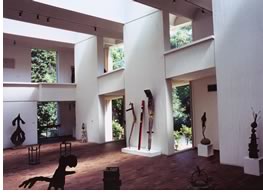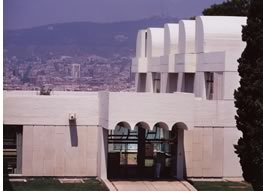
Modern Mediterranean masterpiece stands the tests of time
 Fundació
Joan Miró (the Miró Foundation), Barcelona's sculpturally
Modern museum dedicated to its world-acclaimed Modern artist, has been
named recipient of the AIA's 2002 Twenty-fiveYear Award. The award is
conferred annually on a building project 25 to 35 years old that exemplifies
design of enduring significance.
Fundació
Joan Miró (the Miró Foundation), Barcelona's sculpturally
Modern museum dedicated to its world-acclaimed Modern artist, has been
named recipient of the AIA's 2002 Twenty-fiveYear Award. The award is
conferred annually on a building project 25 to 35 years old that exemplifies
design of enduring significance.
Completed in 1975 and designed by AIA Gold Medalist Josep Lluis Sert of the noted American firm Sert Jackson and Associates, Lexington, Mass., the Miró Foundation was conceived to grace Barcelona's Parc de Montjuic, house the internationally renowned works of Joan Miró, and serve as a center for the study of contemporary art.
Master work for architect
and artist
Pulitzer Prize-winning architecture critic for the Boston Globe Robert
Campbell, FAIA, noted, "The Miró Foundation is the perfect
setting for the works of the architect's childhood and lifelong friend,
Joan Miró, with whose work Sert was in deep sympathy, and whose
colors Sert frequently incorporated into his own architecture. The building
is also the culmination of Sert's career-long effort to marry the logic
and rigor of the Modern Movement with the vernacular architecture of the
Mediterranean, which he loved and admired for being so responsive to climate
and culture."
 Offering
myriad, carefully proportioned spaces of varying sizes and light, the
museum features larger galleries for objects that demand distant viewing
as well as high-ceilinged spaces for vertical paintings and hangings.
The architects also designed small rooms suitable for close-up viewing
of more diminutive paintings and graphics. The building's sole octagonal
volume, rising to the right of the entrance, houses an auditorium on its
lowest level. On the floor above is a gallery for graphic works, and on
the uppermost level, lighted from above, sits the library. The basement
level supports administrative and curatorial spaces.
Offering
myriad, carefully proportioned spaces of varying sizes and light, the
museum features larger galleries for objects that demand distant viewing
as well as high-ceilinged spaces for vertical paintings and hangings.
The architects also designed small rooms suitable for close-up viewing
of more diminutive paintings and graphics. The building's sole octagonal
volume, rising to the right of the entrance, houses an auditorium on its
lowest level. On the floor above is a gallery for graphic works, and on
the uppermost level, lighted from above, sits the library. The basement
level supports administrative and curatorial spaces.
The volumes of the varied exhibition spaces gain further definition from the rooftop's famed hooded monitors, which also serve to soften the building's Mediterranean-white profile on the horizon. The sculpted monitors admit daylight through diffusing glass and reflect it without shadow to the galleries below. At viewer level, diffused light is selectively fortified by direct daylight entering the glazed walls.
Celebrating the human
spirit
"What is extraordinary in retrospect is the significant use of natural
light, scale-giving form, a measure of tactility," the awards jury
observed. "This in a time when there was an obsession with structural
monumentalism and mono-material buildings that yielded scaleless, dehumanized,
oftentimes aggressive environments. It is a structure that celebrates
the human spirit as interpreted by the artist, in the culture of the place.
The tools of the artist; material, color and light, are the tools of the
architect," the jury added.
 In
nominating the Miró Foundation for the award, Henry S. Reeder,
FAIA, 2000 chair of the AIA's Committee on Design, wrote: "This is
a project that is coherent in its part, and in the relation of those parts
to the whole. Its expression grows directly from the essential elements:
galleries with lighting monitors, vertical auditorium/library linked by
lower circulation elements."
In
nominating the Miró Foundation for the award, Henry S. Reeder,
FAIA, 2000 chair of the AIA's Committee on Design, wrote: "This is
a project that is coherent in its part, and in the relation of those parts
to the whole. Its expression grows directly from the essential elements:
galleries with lighting monitors, vertical auditorium/library linked by
lower circulation elements."
The Miró Foundation, which gained an addition in 1998 by Sert-trained architect Jaime Freixa, has maintained its appearance and design intent in immaculate condition. The foundation continues to serve as a widely visited museum and a center for the study of contemporary art.
The Twenty-five Year Award will be presented at
the American Architectural Foundation's 2002 Accent on Architecture awards
ceremony March 1 in Washington, D.C.
Copyright 2001 The American Institute of Architects. All rights reserved.
![]()
|
The Twenty-five Year Award will be presented at the American Architectural Foundation's 2002 Accent on Architecture awards ceremony March 1 in Washington, D.C. Photos courtesy of the architect. |
|